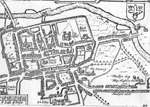
|
John Speed's plan of Colchester, 1610 John Speed (?1552-1629), was a map-maker and imitator of Saxton and Norden. The town walls and gates of Colchester are visible in Speed's plan. They form the playing card shape which is so distinctive of Roman military forts or sites, together with the streets running in a regular pattern north-south and east-west from the central area to the walls. Colchester inherited the Balkerne Gate, close to St.Marye's on the west, and much of its walling from antiquity. The 'Castell', [old spelling and a reminder that English was a coming and vernacular language in which spellings varied], occupies the site of the former temple dedicated to the Emperor Claudius. But by the C16th, houses have begun to extend beyond the town walls and along the major roads in a ribbon development, [see East Street running down to the River Colne (Colne Flumen) and its water mill with wheel visible,]. Distances are scaled here in paces, (long 's'). Tudor Colchester has newly been assessed.18 The early C16th saw Colchester in decline as the cloth trade upon which it depended struggled. The borough began to recover during the middle of the century and its economy was 'greatly boosted from 1565 by the arrival of Dutch immigrants who introduced the manufacture of new draperies, the lightweight 'bays' and 'says'.19 Estimates of the population based on subsidy returns suggest a figure in the range of 3-5,000 climbing to a total of 11,000 by the 1620s, (including 1,535 Dutch). This growth was interrupted by outbreaks of epidemic disease. The years 1514, 1545, 1557-9, 1586-8, and 1597 had a particularly high mortality. The high death rate in 1557-9 was probably caused by the national epidemic of influenza and typhus in those years, while that of 1597 was possibly due to either famine or disease induced by malnutrition, the result of four successive years of high grain prices. There were a few but costly royal visits to the town. In 1515, when Catherine of Aragon came on her way to visit Walsingham in Norfolk she was given a purse and £10. In 1544 the baliffs were ordered to prepare provisions for 1,600 - 2,000 horse accompanying Henry VIII to Harwich. Colchester declared for Mary at her accession on 19 July and the queen travelled through the town from Framlingham to London on 26 July 1533. The streets were repaired for her visit and she was presented with a silver gilt cup and cover and £20. Elizabeth I spent two or three days in Colchester in 1561 and seems also to have been presented with a silver gilt cup and £20. Colchester was by far the largest town in Essex and housed the county gaol in its castle. A number of its residents became distinguished. Thomas Audley, a lawyer from Earls Colne, moved on to become the town clerk in 1514 and entered royal service ending up as Lord Chancellor. William Gilbert, or Gilberd, (d.1603), son of Jerome Gilberd, went from Colchester to study at Cambridge and became physician to Elizabeth I, though his lasting fame rests more now upon his authorship of the pioneering study of magnetism, De Magnete, (1600). |
||||
 |
